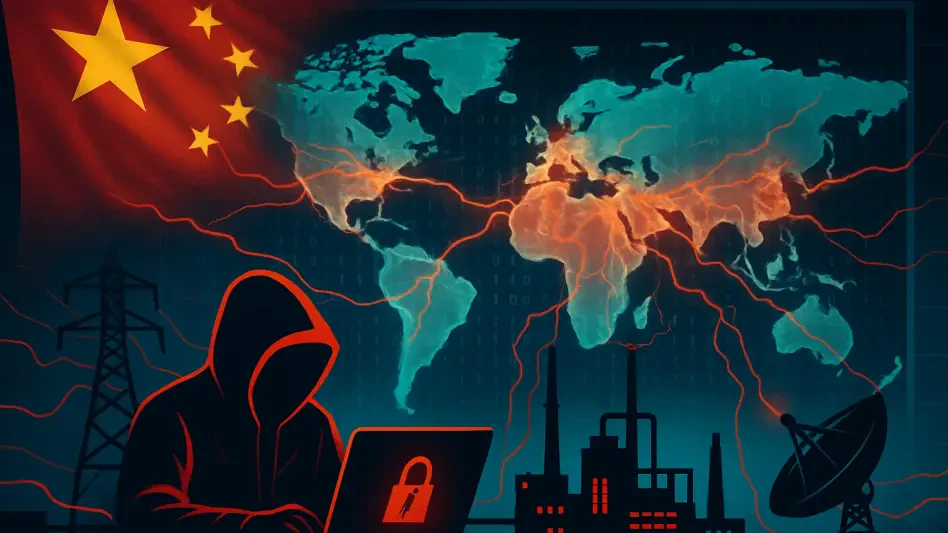In a startling revelation that has sent shockwaves through the international cybersecurity community, the United Kingdom and the United States, alongside a coalition of twelve other nations, have pointed fingers at three China-based technology firms for orchestrating a sprawling campaign of cyberattacks targeting critical global infrastructure. This collaborative accusation, backed by extensive investigations from cybersecurity agencies, underscores a persistent and audacious threat that has been unfolding for years. The implicated companies—Sichuan Juxinhe Network Technology Co Ltd, Beijing Huanyu Tianqiong Information Technology Co, and Sichuan Zhixin Ruijie Network Technology Co Ltd—are alleged to have provided cyber services to Chinese intelligence, enabling attacks on sectors as vital as government, telecommunications, transportation, and military. The scale of this operation raises pressing questions about the security of global systems and the vulnerabilities that remain unaddressed, setting the stage for a deeper examination of this alarming issue.
Unmasking a Persistent Cyber Threat
The accusations leveled by this international coalition reveal a cyber campaign of unprecedented scope, targeting the very backbone of global infrastructure with chilling precision. Since at least the mid-2020s, these attacks have compromised sensitive data across multiple sectors, potentially allowing Chinese intelligence to monitor communications and track movements on a massive scale. The methods employed, while not overly complex, exploit well-known vulnerabilities in widely used technologies from major vendors like Ivanti, Palo Alto Networks, and Cisco. What stands out is the audacity of the operation, described by cybersecurity leaders as an unrestrained wave of malicious activity. The focus on critical sectors suggests a strategic intent beyond mere data theft, hinting at broader geopolitical motives. This situation demands urgent attention, as the stolen information could have far-reaching consequences for national security and international relations, exposing gaps in defensive measures that many believed were secure.
Further delving into the nature of this threat, it becomes evident that the simplicity of the attackers’ tactics is both surprising and concerning. Rather than relying on cutting-edge tools or novel exploits, the perpetrators have capitalized on outdated flaws that could have been mitigated through basic security updates. This highlights a systemic failure among targeted organizations to maintain proper cybersecurity hygiene. Government agencies, telecommunications firms, and transportation hubs, among others, have been caught off guard by their own negligence in patching known issues. Expert commentary from the cybersecurity field emphasizes that this is not just a technical lapse but a wake-up call for industries worldwide to prioritize routine maintenance and vigilance. The fact that such preventable breaches have enabled large-scale espionage underscores the need for a cultural shift in how organizations approach digital defense, lest they remain easy targets for state-sponsored actors.
The Ecosystem Behind the Attacks
Beyond the specific firms accused, a broader network of facilitators within China appears to be fueling this cyber campaign, creating a sophisticated ecosystem of espionage. Analysts from leading threat intelligence groups have noted that contractors, academics, and other entities are intricately involved, providing resources and expertise that scale these operations to alarming levels. This network’s deep understanding of telecommunications systems gives attackers a unique advantage, allowing them to evade detection with relative ease. The targeting of sectors like hospitality and transportation further suggests an intent to conduct detailed surveillance, tracking individuals’ locations and communications with precision. Such capabilities point to a level of coordination and support that transcends isolated hacking efforts, painting a picture of a well-orchestrated strategy aimed at gathering intelligence on a global scale. This revelation raises serious concerns about the extent to which state-backed operations can infiltrate everyday systems.
Adding to the complexity of this issue is the sheer diversity of targets and the implications for personal privacy. Unlike traditional espionage, which often focuses on military or governmental secrets, this campaign appears to prioritize granular data about individuals—where they travel, whom they contact, and what they discuss. This shift in focus indicates a potential for widespread monitoring that could affect ordinary citizens far removed from geopolitical conflicts. Experts argue that the existence of such a robust support system within China, including academic and commercial collaborators, amplifies the threat by providing attackers with endless resources and knowledge. The international community must grapple with the reality that these operations are not merely technical challenges but strategic maneuvers designed to reshape global power dynamics through information dominance. Addressing this requires not just technological solutions but also diplomatic efforts to curb such extensive cyber networks.
Strategies for Defense and Mitigation
In response to this escalating threat, cybersecurity agencies across the coalition have issued urgent recommendations for organizations to bolster their defenses. A primary step involves conducting immediate network scans to detect any signs of malicious activity, ensuring that any presence of attackers is fully understood before attempts are made to evict them. Additionally, securing internet-facing devices with the latest updates is non-negotiable, as many of the exploited vulnerabilities stem from outdated systems. Leaders in the field stress the importance of continuous monitoring for anomalies, a practice that can mean the difference between a minor breach and a catastrophic compromise. These actionable measures aim to close the gaps that attackers have exploited so effectively, urging a proactive stance rather than a reactive one. For many organizations, this advice serves as a critical reminder that cybersecurity is an ongoing commitment, not a one-time fix.
Equally important is the need for a broader cultural shift within industries to prioritize cybersecurity as a core operational concern. Too often, the responsibility for updates and patches falls through the cracks amid competing priorities, leaving systems vulnerable to exploitation. Agencies advocate for a mindset of vigilance, where regular audits and employee training become standard practice. The simplicity of the attackers’ methods—relying on known flaws rather than sophisticated malware—underscores how preventable many of these breaches could have been. By fostering a culture that values digital hygiene, organizations can significantly reduce their risk of becoming targets. This approach, combined with international cooperation to share threat intelligence, offers a pathway to counter the pervasive threat posed by state-sponsored cyber campaigns. The focus must remain on building resilient systems that can withstand the evolving tactics of adversaries.
Reflecting on a Global Challenge
Looking back, the collaborative effort by the UK, US, and their allies to expose this extensive cyber campaign marked a pivotal moment in addressing state-sponsored digital threats. The accusations against the three Chinese technology firms served as a stark reminder of how interconnected and vulnerable global systems had become. The simplicity of the exploitation tactics, paired with the complex network supporting these attacks, revealed deep-seated issues in cybersecurity practices worldwide. What stood out was the urgent need for organizations to adopt proactive measures, from patching vulnerabilities to enhancing monitoring capabilities. Moving forward, the international community was encouraged to strengthen partnerships, share critical intelligence, and invest in robust defenses to prevent similar campaigns from succeeding. This episode underscored that safeguarding digital infrastructure was not just a technical necessity but a strategic imperative for preserving national security and personal privacy in an increasingly connected world.








